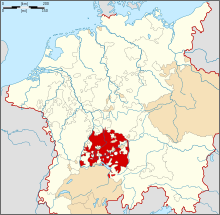Buchau Abbey
The Imperial Abbey of Buchau (German: Reichsstift Buchau) was initially a monastery of canonesses regular, and later a collegiate foundation, in Buchau (now Bad Buchau) in Baden-Württemberg, Germany. The abbey was a self-ruling Imperial Estate and its abbess had seat and vote at the Imperial Diet.
Imperial Abbey of Buchau on the Federsee Reichsstift Buchau am Federsee | |||||||||
|---|---|---|---|---|---|---|---|---|---|
| 1347–1803 | |||||||||
| Status | Imperial Abbey | ||||||||
| Capital | Buchau Abbey | ||||||||
| Common languages | Alemannic | ||||||||
| Government | Elective principality | ||||||||
| Historical era | Early modern period | ||||||||
• Founded | 770 | ||||||||
| 1347 | |||||||||
• Converted to secular foundation | 1415 | ||||||||
1625 | |||||||||
| 1803 | |||||||||
• Ceded to Württemberg | 1806 | ||||||||
| |||||||||
| Today part of | |||||||||
According to tradition, the monastery was founded around 770 on an island in the Federsee by the Frankish Count Warin and his wife Adelindis (still commemorated in the local Adelindisfest). The abbey was put on a secure financial footing by Louis the Pious, who in 819 granted the nuns property in the Saulgau and in Mengen. In 857, Louis the German declared it a private religious house of the Carolingian Imperial family and appointed as abbess his daughter Irmingard (died 16 July 866).



The abbey was initially a house of canonesses regular, but at a later date it was converted into a collegiate foundation of secular canonesses who belonged to various noble families of Swabia. In 1347, Buchau Abbey gained Imperial immediacy and the abbess was raised to the rank of Princess-Abbess. The abbey was an Imperial Estate and its abbess had seat and vote at the Imperial Diet.
In the 13th century as well, the town of Buchau, which had grown in the immediate vicinity of the monastery, gained the status of a Free imperial city after a long period of strife between the townspeople and the abbey. From then on and until 1803, Buchau Abbey and the Imperial City of Buchau, both self-governing entities fully independent of each other, were forced to cohabit. Unlike most of the other Free Imperial Cities, Buchau was to remain Catholic in the course of the Reformation.
In 1415, the abbey became a secular foundation and from then on the congregation was to be composed of an abbess, twelve choir women (Chofrauen) and two chaplains. The abbess, as an Imperial Estate, had seat and voice in the Reichstag. Buchay Abbey had a small territorial base and in 1625 the lordship of Strassberg also became part of the Abbey.
In the course of the secularisation of 1803, Buchau Abbey was dissolved like all the other Imperial Abbeys and its territory and assets passed to the prince of Thurn und Taxis, then to the Kingdom of Württemberg in 1806. The lordship of Strassberg however was annexed to the Principality of Hohenzollern-Sigmaringen.
The abbey church of Saints Cornelius and Cyprian, one of the first neo-classical buildings in southern Germany and still showing some late Baroque features, was built between 1774 and 1776 by Pierre Michel d'Ixnard as a conversion and refurbishment of a Gothic church. It includes stucco sculptures by Johann Joseph Christian.

References
External links

- (in German) Map of Swabia, 1789
- (in German) Das (freiweltliche) Damenstift Buchau am Federsee at Google Books, by Bernhard Theil, 1994. ISBN 978-3-11-014214-3

